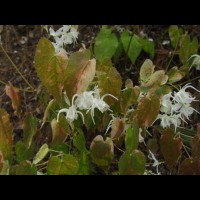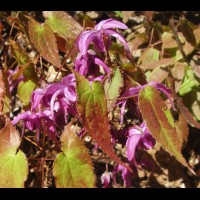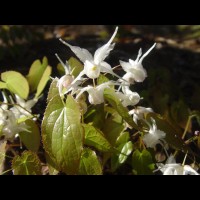Epimedium sempervirens
Native to the Japan Sea side of Honshu, Japan. Semi-evergreen leaflets usually of medium size. Flowers generally produced above the leaves, medium/large in size; typically white, sometimes lavender, purple and rose-red, with long spurs and a cup. Clump-forming unless otherwise noted. Usually has no second flush of growth.
Epimedium sempervirens
Epimedium sempervirens Cc. 950031
Medium-sized, crisp, white flowers bloom above long tapered leaflets. One of the earliest epimediums to bloom in spring. Foliage makes an 8” mound. Spring leaflets are touched with a band of red around their edge. A bright little harbinger of spring. Semi-evergreen.
Epimedium sempervirens "Variegated #1"
Epimedium sempervirens “Variegated #1” (Cc. 970190)
From Japan came rumors of a most spectacularly variegated Epimedium heavily dappled with white and pink and costing a small fortune. During Darrell's 1997 trip to Japan with Dan Hinkley he searched specifically for this fabled plant. Once he saw it he just had to have it—the most expensive Epimedium he's ever purchased! It was indeed the nicest variegated Epimedium he'd ever seen...and just as they said, the spring foliage is a swirling collage of creamy white, salmon-pink and apple green. What they didn’t mention was that the white portion of the variegation lasts well into the season.. into August here, before turning mostly green.
White flowers are produced above the semi-evergreen leaves. One of the shorter Epimediums at only 8” tall.
Epimedium sempervirens "Variegated #2"
An exceptional variegated form of Epimedium sempervirens. Strong grower despite the generous amount of foliage that is speckled and splotched with white. Medium lavender-rose flowers. Foliage 6 to 8" high at maturity. Keeps its variegation well into late summer. Limited quantity. Darrell obtained this clone from Japan. It will be a special conversation piece in your garden.
Epimedium sempervirens "Violet"
E. sempervirens “Violet” (Cc. 950069)
One of my absolute favorites. Grown for many years by Harold Epstein, Epimedium enthusiast, this may be a named Japanese cultivar. Medium-sized lavender flowers have spurs that curve inward back towards the cup. Flowers are held above medium-sized leaflets on stems to 9” high. Unusually long, narrow leaflets sport irregular dark flecking in the spring. Semi-evergreen.
Epimedium sempervirens 'Aurora'
E. sempervirens ‘Aurora’ (Cc. 920018)
Dwarf form with large, dark silky, silvery lavender blooms with glossy, small/medium-sized leaflets. 6" tall in bloom with a second flush to 9". The new growth displays occasional dark flecking in spring. Second flush may have a pink blush as the photo shows. Often has good orange-red fall color when grown in bright shade or some sun. Named by Dick Weaver and sold by We Du as a cultivar of E. grandiflorum. Semi-evergreen.
Epimedium sempervirens 'Candy Hearts'
Epimedium sempervirens ‘Candy Hearts’ (Cc. 920038)
***2001 Cobblewood Introduction***
Exquisite spring foliage emerges an opalescent rosy-pink tone that slowly recedes over a month’s time to a rose border, before turning solid green. The showy large silvery lavender-pink flowers have wide inner-sepals and look like iridescent pearls against the colorful spring foliage. 9” tall. Semi-evergreen with medium-sized leaflets.
Epimedium sempervirens 'Cherry Hearts'
Epimedium sempervirens ‘Cherry Hearts’ (Cc. 950016)
***2001 Cobblewood Introduction***
As Darrell began to sort out Epimediums in cultivation years ago, Don Elick kindly sent him this plant as “true” E. sempervirens. True it might be and while its large flowers are the usual white, with the typical evergreen leaves, the new spring foliage is anything but. Emerging a vibrant cherry red, it later turns green leaving a cherry edge before fading to summer green.
Epimedium sempervirens 'Creamsickle'
Epimedium sempervirens 'Creamsickle' (Cc. 050060)
I have been growing several variegated forms of E. sempervirens, and have finally decided that this one is different enough to offer. The new spring growth surrounds its clean, white flowers a riot of deep pink and olive green swirls of color for several days during bloom. Later the leaves green up, holding onto traces of white variegation. Leaves are more limey-green in variegation than the other E. semp. 'Variegated #1' that Darrell bought in Japan, and have offered for years.
Epimedium sempervirens 'Koji'
E. sempervirens ‘Koji’ (Cc. 930003)
An attractive Japanese cultivar with sprays of large, medium lavender flowers with white highlights that hover above a mass of medium-sized leaflets 10” tall. New spring leaflets flushed with bronze. A very early bloomer.
Epimedium sempervirens 'Mars'
Epimedium sempervirens ‘Mars’ (Cc. 920035)
A rare, rose-red form of this species, named by Dick Weaver from a plant he purchased from Japan. 6” tall in bloom with a second flush to 10” tall. Medium-sized leaflets. When grown well, ‘Mars’ produces up to 30 or more flowers per stem, forming a dense head. Very showy. Medium/large, dark rose-red flowers. Rusty red/salmon fall color.
Epimedium sempervirens 'Okuda's White'
Epimedium sempervirens ‘Okuda’s White’ (Cc. 950036)
Introduced from Japan by George Schenk in the 1970’s. A rare and unusual spreading form of E. sempervirens, with 2-4” long rhizomes. The large, white flowers are typical of the species. Grows to 6-8” tall. Forms a nice, short, semi-evergreen groundcover over time. An early bloomer.
Epimedium sempervirens 'Passion Hearts'
Epimedium sempervirens ‘Passion Hearts’ (Cc. 180040)
***2019 Cobblewood Introduction***
A great, new introduction from Massachusetts hybridizer Mark McDonough. Spring foliage emerges a deep chocolate brown and warms up as spring progresses, through a kaleidoscope of vibrant red tones. Eventually the color fades to the edges before greening up in a tidy mound of elongated, heart-shaped leaflets. Generous clusters of medium-sized flowers with light lavender sepals and a lighter cup dot the low mound of colorful spring foliage. Semi-evergreen.
Epimedium sempervirens 'Rose Dwarf'
E. sempervirens ‘Rose Dwarf’ (Cc. 950027)
Originally offered by George Schenk in the 1970’s and still quite rare in the trade. We thank Jerry Flintoff for our original stock. Plants 5” tall in bloom with unusually long, narrow, medium-sized leaflets, gradually tapering to a thin point and flecked with bronze in the spring. Flowers similar to those of Violet Queen’, dark violet-lavender with long inner-sepals. An early bloomer. Semi-evergreen.
Epimedium sempervirens 'Secret Arrow'
Epimedium sempervirens ‘Secret Arrow’ (Cc. 950140)
***2000 Cobblewood Introduction***
Unique, arrow-shaped leaflets distinguish this plant. Large lavender flowers face out¬ward with wide inner-sepals. Cool fall temperatures turn the leaves a beautiful salmon-egg red, with limey green streaks along the main veins
Epimedium sempervirens 'Shadow Dancer'
E. sempervirens ‘Shadow Dancer’ (Cc. 000943)
***2010 Cobblewood Introduction***
This Japanese sempervirens selection has strikingly beautiful banded foliage with a royal purple edge in spring, surrounding a interior flushed with purple. The large, violet-lavender blossoms have uniform coloring throughout. Grows to 12” in height. Semi-evergreen.
Epimedium sempervirens 'Snowshoe Lake'
Epimedium sempervirens ‘Snowshoe Lake’ (Cc. 920033)
***2014 Cobblewood Introduction***
A white flowered very floriferous form of this extremely early bloomer. Sited in bright shade or a couple of hours of sun a day, it will produce clouds of clean white medium-sized flowers, 6” above the ground at the first thaw. Leaflets sport a delicate red line along their margins in early spring.
A cheerful and fitting tribute to my late brother George who lived on Snowshoe Lake in Alaska. 8-10” at maturity. An early bloomer.
Epimedium sempervirens 'Vega'
E. sempervirens ‘Vega’ (Cc. 950211)
Named by Dick Weaver in 1995, but Darrell doesn’t think that he ever introduced it. He said, “the foliage seems almost varnished while young. It virtually glistens and it is still very glossy” (in mid-June). Dick’s original plant was from Leola Fraim of Waltham, MA in 1984. She received it from Florence Shaw in 1968. Leaflets remain glossy all season here, on stems to 6”. Pristine white flowers.
Epimedium sempervirens 'Violet Queen'
Epimedium sempervirens ‘Violet Queen’ (Cc. 950138)
A spectacular Epimedium. This clone is an exact match for the plant originally named Epimedium violaceum in 1834 which was later changed to a variety of E. grandiflorum... all through the study of dried herbarium specimens. However, this plant is semi-evergreen and nearly identical to other clones Darrell received from west central Honshu including the plant depicted in Don Elick’s book, Japonica Magnifica. Perhaps it is a species of its own. This is the parent that gifted E. x rubrum, E. x versicolor ‘Versicolor’ and ‘Cupreum’ with colorful spring foliage.
Prized for its vibrant, cherry-red new growth and large, rich violet-lavender flowers with very long inner-sepals. Small/medium leaflets have a long, tapered point. Slow to propagate. 12”























